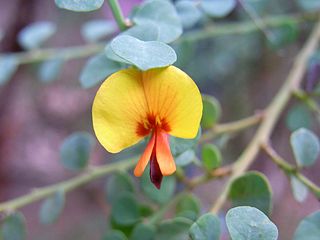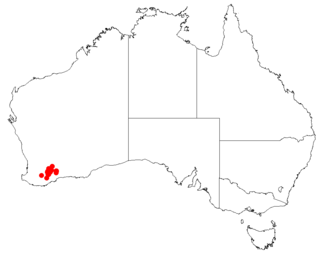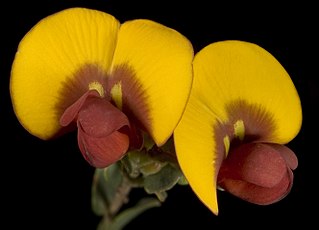
Hakea salicifolia, commonly known as the willow-leaved hakea, is a species of flowering plant that is endemic to eastern Australia. It is an adaptable, fast growing small tree or shrub with attractive foliage and cream white flowers.

Bossiaea is a genus of about 78 species of flowering plants in the pea family Fabaceae and is endemic to Australia. Plants in this genus often have stems and branches modified as cladodes, simple, often much reduced leaves, flowers with the upper two sepal lobes larger than the lower three, usually orange to yellow petals with reddish markings, and the fruit a more or less flattened pod.

Allocasuarina distyla, commonly known as scrub she-oak, is a species of flowering plant in the family Casuarinaceae and is endemic to south-eastern New South Wales. It is a dioecious shrub that has branchlets up to 350 mm (14 in) long, the leaves reduced to scales in whorls of six to eight, the fruiting cones 13–35 mm (0.51–1.38 in) long containing winged seeds (samaras) 4.0–8.0 mm (0.16–0.31 in) long.

Bossiaea foliosa, commonly known as leafy bossiaea, is a species of flowering plant in the family Fabaceae and is endemic to south-eastern Australia. It is an erect shrub with small, broadly egg-shaped to round leaves, and bright yellow flowers.

Bossiaea cordigera , commonly known as wiry bossiaea, is a species of flowering plant in the family Fabaceae and is endemic to southern Australia. It is a straggling shrub with wiry branches, egg-shaped to more or less heart-shaped leaves and yellow and red flowers.

Bossiaea rhombifolia, is a species of flowering plant in the family Fabaceae and is endemic to eastern Australia. It is an erect, glabrous shrub with diamond-shaped, more or less round or broadly egg-shaped leaves, and yellow and red or pinkish flowers.

Bossiaea obcordata, commonly known as spiny bossiaea, is a species of flowering plant in the family Fabaceae and is endemic to south-eastern continental Australia. It is an erect, rigid shrub with spiny branches, heart-shaped to egg-shaped with the narrower end towards the base, and yellow and purplish-brown flowers.

Bossiaea linophylla is a species of flowering plant in the family Fabaceae and is endemic to the south-west of Western Australia. It is a spreading shrub with linear to oblong or egg-shaped leaves, and bright yellow to orange or apricot-coloured and red flowers.

Bossiaea tasmanica is a species of flowering plant in the family Fabaceae and is endemic to Tasmania. It is a prostrate or low-lying shrub with spiny branches, elliptic to egg-shaped with the narrower end towards the base, and yellow and red to pink flowers.

Bossiaea decumbens is a spreading, prostrate shrub in the pea family (Fabaceae), and is endemic to Victoria. It has alternate, variable shaped leaves and yellow pea flowers with red splotches from spring to late summer.

Bossiaea halophila is a species of flowering plant in the family Fabaceae and is endemic to Western Australia. It is a dense, erect, many-branched shrub with narrow-winged cladodes, leaves reduced to small scales, and yellow-orange and deep red flowers.

Bossiaea carinalis is a species of flowering plant in the family Fabaceae and is endemic to eastern Queensland. It is an erect shrub with narrow egg-shaped to lance-shaped leaves and pink to red and yellow flowers.

Bossiaea concolor is a species of flowering plant in the family Fabaceae and is endemic to eastern Australia. It is an erect shrub with elliptic to oblong or egg-shaped leaves with the lower end towards the base, and yellow and red flowers.
Bossiaea cucullata is a species of flowering plant in the family Fabaceae and is endemic to Western Australia. It is a dense, many-branched shrub with narrow-winged cladodes, leaves reduced to dark brown scales, and yellow and deep red or pale greenish-yellow flowers.
Bossiaea dasycarpa is a species of flowering plant in the family Fabaceae and is endemic to a small area in eastern Australia. It is a prostrate or low-lying shrub with narrow oblong to narrow elliptic leaves, and yellow and red flowers.
Bossiaea distichoclada is a species of flowering plant in the family Fabaceae and is endemic to south-eastern continental Australia. It is an erect shrub with hairy branches, kidney-shaped to more or less round or heart-shaped leaves with the narrower end towards the base, and uniformly bright yellow flowers.
Bossiaea eremaea is a species of flowering plant in the family Fabaceae and is endemic to Western Australia. It is an openly-branched, spreading, more or less leafless shrub with deep yellow and purplish flowers.
Bossiaea obovata is a species of flowering plant in the family Fabaceae and is endemic to eastern Australia. It is a small, low-lying or prostrate shrub with egg-shaped leaves with the narrower end towards the base, and pea-shaped, yellow and red flowers.

Bossiaea pulchella is a species of flowering plant in the family Fabaceae and is endemic to the south-west of Western Australia. It is a slender, erect shrub with egg-shaped leaves, and orange-yellow, purplish brown and dark red flowers.

Bossiaea scortechinii is a species of flowering plant in the family Fabaceae and is endemic to eastern Australia. It is a prostrate to low-lying shrub with simple, elliptic to egg-shaped leaves with the narrower end towards the base, and orange-yellow flowers with red to pinkish markings.
















